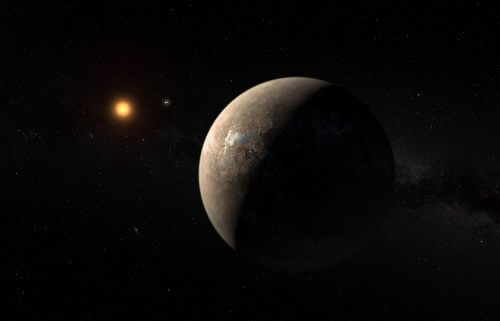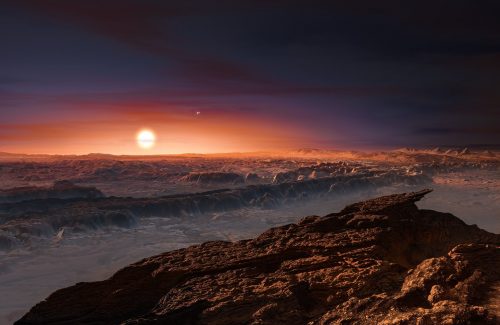Proxima Centauri B - a recently discovered planet, has the potential to support life. It is similar to the Earth in terms of size and temperature, but is much closer to its sun, and therefore may absorb radiation at a dangerous level

Written by: Dr. Netzah Farbiash, Young Galileo
In August of this year, the discovery of a planet that was not known until now, whose properties may resemble those of the Earth, was announced. The planet Proxima Centauri B is located in the "life zone" - an area that allows the existence of liquid water (this still does not mean that it does exist on its surface). This planet is 4.25 light years away from us.
far but close
A year ago we excitedly announced the discovery of the planet Kepler-452 b, which may have properties similar to those of the Earth. However, this is a very distant planet, which is about 1,400 light years away from us, which means that to reach it we would have to travel at the speed of light (about 300 kilometers per second) for 1,400 years. Now, with the discovery of a planet whose properties may resemble those of Earth, which is "just around the corner" in astronomical terms, at a distance of "only" 4.25 light years from us - the scientific community is excited again. This planet orbits a red dwarf - a small and relatively pale sun, named Proxima Centauri (Proxima - close; Centaurus - the name of a constellation), therefore it is called Proxima Centauri B.
The reason for the excitement lies in the fact that, unlike Kepler-452 b - even if the conditions for the existence of intelligent life are met, the chance of communicating with them is zero (it is assumed that the duration of existence of a civilization that has the ability to transmit and receive information is infinitely shorter than the existence of a planet). In the case of Proxima Centauri B, we are dealing with time periods of "only" 4.25 light years (a long time to wait for a response to a message, but still within a human lifetime). Although this is a distance that allows light (and information) to travel in a reasonable amount of time for humans, the physical journey to it is far from practical with existing technologies. Even the fastest spaceships available to us today will take tens of thousands of years to get there.

Similar but different
Proxima Centauri B is a rocky planet, slightly larger than Earth. Its distance from its sun (Proxima Centauri) is seven million kilometers (for comparison, the Earth is 150 million kilometers away from the sun), and it orbits it every 11.2 days (a particularly short year...). Proxima Centauri B is located within the "life zone" - an area that allows liquid water to exist on its surface. Although there is a similarity between it and the Earth in terms of size, rockiness and temperature, we still cannot assume that it is suitable for the existence of life (like those that are known to us at least), since the Earth has other conditions, such as a suitable atmosphere and a magnetic field, that protect us from being hit by radiation and energetic particles from space .
In contrast to the similarity of Proxima Centauri B to Earth, its sun - Proxima Centauri - is very different from our sun. Proxima Centauri is a red dwarf star. Its diameter is about one-seventh the diameter of the sun, and its brightness is 600 times smaller than that of the sun. It seems that despite the close proximity of Proxima Centauri B to its Sun, the temperature on its surface allows the existence of liquid water, since its Sun is very pale. Proxima Centauri emits X-ray radiation at about the same intensity as our Sun, but due to its proximity to its Sun - the planet absorbs an X-ray radiation flux 400 times higher than Earth's. Such X-ray bones are dangerous to life as we know it.
Due to the proximity of Proxima Centauri B to its sun, it may be in a "locked" state. Like the moon, which always faces the same side to the earth, Proxima Centauri B may always face the same side to its sun. The result is that the side facing the sun will be very hot, and the other side - very cold.
Despite the difficulties in the development of life similar to those known to us, it is possible that other forms of life developed on it. Living under a thick mantle of water, for example, may be more protected from the radiation. Trying to understand what life forms there might look like can be a special adventure.
The increasing amount of information is increasing rapidly. Apparently, we will hear very soon about the discoveries of other planets that are similar to the Earth. Technological equipment under development may bring us photographs and valuable additional information about Proxima Centauri B and others. There is definitely something to look forward to!
The writer is Vice President of Science at Caruso Science Park
The article was published in the Galileo Young Monthly for curious children. For a gift digital sheet Click
More of the topic in Hayadan:
- Life at the seam between the bright side and the dark side: the James Webb Space Telescope will be able to examine the composition of the atmosphere of Proxima Centauri b
- The Israeli astrophysicist's journey to Proxima Centauri
- Is there life on the nearest planet, Proxima Centauri b?
- ESO confirms: Terrestrial planet discovered around Proxima Centauri, the closest star to the Solar System

3 תגובות
A flight there would take tens of thousands of years. It seems that NASA is just looking for budgets.
Mars is also located in the zone of life and is much closer to us, no life was found there. So enough with your enthusiasm and speculation, it sounds ridiculous. We are so far away and the information we have is so little that we don't even see this star directly with a telescope.
If there is a chance to find life, then it is better to first invest energy in the planets of the solar system, such as the moon Europa, for example, which is probably an ocean of salty water with a layer of ice on top, and today there is the technology to land on it.
It is unlikely that we are in another home universe. It is much more practical to maintain the house where we live. !!